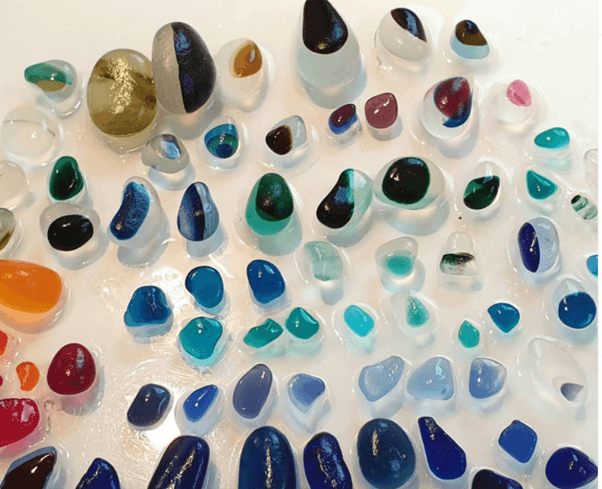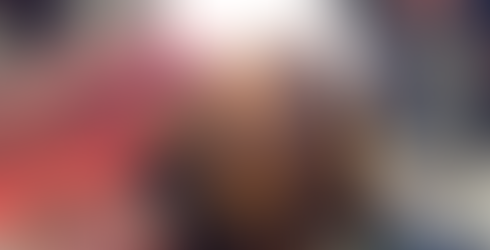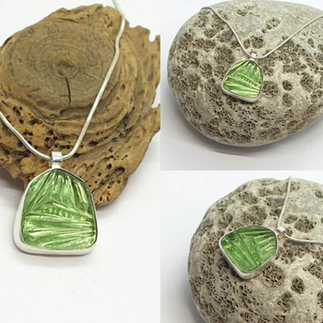A rainbow in glass
- Lizzie Hudson
- Mar 16, 2022
- 11 min read
One of the most fascinating things about sea glass, is the huge array of colours it can be found in. Whether you collect sea glass for your profession, or merely pick up the pieces you come across when walking on a beach, you will sooner or later come to realise that some colours are more common than others, and some beaches have a tendency for some shades of sea glass more than other shades.
To fully appreciate the colours of sea glass, we really need to understand what glass is in the first place. Very simply, glass is silica sand melted at extremely high temperatures (around 1700ºC/3090ºF) to become molten, then when cooled, it transforms into another state. The glass we are most familiar with today is made from soda, limestone, and sand from quartz crystals, and is known as soda-lime glass. Some historians believe that glass was first made in Mesopotamia around 2,500BC.
Why colour glass?
The question that could be asked, is why is glass coloured at all? And although it may seem a slightly naive question to ask in the first place, the answers to the question - of which there are several - are interesting, and some for good reason. Adding colour to glass is a complex science, so again, essentially, glass is coloured by the addition of metals, metal oxides and/or compounds during the making process. Uncoloured glass is in fact not clear or white at all but has a faint shade of green/blue to it. There are several reasons that glass is coloured:
To keep light out
For decoration
For identification
For health and safety rules and regulations
To preserve the contents
As signs of warning /danger
For signage
Sometimes, compounds are added in the glass making process to take out any colour from the iron and sulphur compounds used. Of these decolourisers, manganese dioxide and cerium oxide are the most common. It is these compounds that, over time with lengthy exposure to sunlight, change some clear glass into the softer, pastel shades of pale amethyst, peach, pink and grey.
Not all Sea Glass is created equal
Sea glass has a rating of rarity when it comes to colour, and this is important to the value of the piece of sea glass. The rarer the colour, the higher the value. Rarity is mainly due to the fact that some colours of sea glass are simply harder to find than others. This could be because of the demand in the past for certain colours, so there was less glass made in a particular colour to begin with. Or, the location of its manufacture around the world played a part, as some colours were more popular with certain cultures, and so manufactured on a higher scale than other glass colours.
The sea glass colours of white, green, and brown, are the most commonly found colours here in the UK, whilst others, such as orange and red, are very rare and on many beaches, never found at all. And we mustn't forget, that as countries the world over start to embrace a 'greener ' ethos and care more about where they dump their rubbish, then this fascinating little find along our seashore, will become even more rare. Just think... that ring, pair of earrings, or piece of sea glass art that you may have, is one day going to be even more precious!
See where your sea glass sits on the Rarity Scale…
Tip: An easy way to help identify the colour of your sea glass, especially when distinguishing between the various blues, turquoises and greens, is to place them side by side on white paper. Sometimes wetting the glass with a little water will help to bring out its true colour.

The rarity chart above lists the twenty-eight main colours of sea glass, along with multi glass, giving their most commonly used names. This scale is an approximation, as some colours are more commonly found on certain beaches around the world, compared to others, but this scale is generally accepted as being the average, and a good guide to go by.
In actual fact, there are many more hues within each of these general colours, each having its own universally-known, descriptive name. Some professional collectors claim that the number is around 80! So, trying not to leave any colour out, here are the generally accepted names that collectors and craftspeople around the world use,
to describe the beautiful rainbow colours of sea glass that wash up along our sea shores. In no order of rarity, and please excuse any I omit...
Navy Blue, Sky Blue, Royal Blue, Royal Sky Blue, Deep Sky Blue, Street Blue, Cadet Blue, Powder Blue, Dark Turquoise, Medium Turquoise, Pale Turquoise, Medium Aqua, Green, Pale Green, Spring Green, Lime Green Emerald, Yellow Green, Medium Yellow Green, Dark Green, Dark Olive, Sea Green, Light Grey, Dark Slate Grey, Medium Amber, Honey Amber, Tan, Khaki, Beige, Sienna, Dark Red, Fire Brick, Crimson, Cherry Red, Orange Red, Dark Orange, Salmon, Lavender, Violet, Indigo, Dark Violet, Orchid, Hot Pink, Light Pink, Medium Purple, and, pauses for breath…
That’s 73 shades of sea glass, including those on the Rarity Scale!
ING RATIO
Rubbish by any other name…

White/Clear
White (or clear) sea glass is one of the most common ‘colours’ to find. The main metal added to make white glass is tin, along with lead for cut crystal. Most sea glass used in jewellery is lightly oiled to bring out its true colour but white sea glass is often left in its naturally frosted state. White glass was mostly used for bottles, jars, tableware, windows.

Brown
Brown sea glass is another common colour and is almost always from bottles (99% actually). From the latter half of the 1800s, brown was a common colour for bottles of beer, medicines, whiskey, etc. It has a finding ratio of 1:2.

Kelly green
This green is the most common green to be found in the UK. Compared to jade green, Kelly green is not as vibrant. This sea glass is mainly from bottles, and small amounts of tableware.

Jade green
When it comes to green sea glass, there are several shades. Jade green is more vibrant than Kelly green and is often found on UK beaches. This sea glass colour is predominantly from bottles and tableware, and was a very popular colour for mineral water bottles of the late 19C. It is a common shade of green to find.

Olive-green
No prizes for guessing what olive-green sea glass was/and still is used for! Yep, olive oil. The olivey-green of this worldwide favourite food oil, is what lends its name to this colour of glass. It is an uncommon sea glass colour to find and, more often than not, found as broken bottle necks and lips. Wine bottles were, and still are, made in this colour.

Amber
Often confused with brown sea glass, amber has more of a reddish/golden brown undertone than actual brown sea glass. It is mostly from bottles and is an uncommon colour to find on the rarity scale. The amber colour is created using the addition of sulphur.

Golden amber
Golden amber is much easier to identify than the darker browns, with a definite golden honey colour to it. Again, this glass colour was mostly used for bottles. Thicker pieces of golden amber are less common to find than the thinner shards. Golden amber is an uncommon colour to find on the scale It is made using the addition of sulphur.

Forest green
Most forest green sea glass is from mineral water bottles from the late 1800s onwards, and today it is a popular colour for wine bottles and an uncommon colour to find on the rarity scale. The forest green colour is made using the addition of iron oxides.

Lime green
Lime green sea glass is an uncommon colour on the scale and most found are from fizzy pop bottles, predominantly from the 1960s and 1970s, although it was used in ornamental glass and tableware but to a lesser degree. This colour is made using the addition of iron oxides.

Soft blue
This is a delicate shade of blue sea glass made with the addition of copper compounds or cobalt in the colouring process. Soft blue sea glass is mainly from soft drinks bottles, perfume bottles, drinking glasses and decorative glassware. It is classed as uncommon on the rarity chart with a finding ratio on average of 1:50.

Sea foam green
This colour is also known as soft green, and is an uncommon colour compared to the likes of brown, white and Kelly green. The majority of sea foam green sea glass is from bottles, the best example of which is the iconic Coca-Cola bottle. This colour of glass was also used for insulators. It has a finding ratio of 1:50+.

Milk glass
This is a semi-translucent glass, whitened by the addition of chemicals and sometimes coloured in pastel shades of pink, pale yellow, pale blue and pale green. It has also been coloured black! Milk glass was first made in Venice in the 16th century. It is also known as opaline, and was commonly used to make decorative tableware. It is not common to find and on some beaches is absent altogether.

Cobalt blue
One of the more popular colours of sea glass is cobalt blue. It is rated as rare on the rarity scale and is not often found on UK beaches. This colour was popular with medicine and poison bottles but was also used for art glass and vases. It has a finding ratio of 1:250.

Pale amethyst (pale purple)
Another rare colour is pale amethyst. Most amethyst sea glass started life as clear glass but during the making process, manganese was added to cancel out the colours of the other ingredients. This manganese slowly oxidized over time, to become a very pale amethyst colour. Amethyst sea glass mainly derives from bottles and decorative tableware.

Citron
This colour sea glass is similar to lime green but with a more olive hue to it. Mostly made into bottles and jars, especially for foodstuffs, and with a small percentage being made into decorative pieces for the table. Again, this is a rare colour of sea glass to find, with a finding ratio of 1:250.

Cornflower blue
Another rare shade of blue is cornflower blue. Softer and slightly lighter than cobalt blue, this shade was mainly used for bottles and decorative tableware. Remember the blue glass of Milk of Magnesia?... a milky medicine, once a popular treatment for indigestion and upset stomachs.

Aqua
Another popular, and nowadays, rare sea glass colour, is aqua. Paler than turquoise, aqua glass was mostly used for bottles and jars for the food industry. It was also the colour used for glass insulators of telephone lines, to prevent electric current loss during transmission.

Pink
Another rare colour to come across is pink, with a finding ratio of around 1:1000. The addition of selenium is an important ingredient in making pink glass. This colour was mainly used to create decorative pieces, vases and Depression Glass, which was an affordable, decorative glass tableware first made in the 1930s Depression Era of America.

Pale-yellow
This gentle shade of glass is a rare colour to find. Made using the addition of sulphur, or lead with antimony, in the colouring process, this was a colour used mainly for vehicle, train and nautical signal lights, and also perfume bottles. It has a finding ratio of 1:1000.

Teal
Teal is an extremely rare colour of sea glass to find on a beach. It was mostly made into bottles, and a small amount as speciality glass. Most teal sea glass found today dates from the pre-1950s. It has a finding ratio of 1:2000.
Black glass (pirate glass)
Probably, the most overlooked and secretive sea glass of them all, is the extremely rare, black sea glass, also known as pirate glass. This glass colour can hide a surprising beauty. Made deliberately thick, and dark by the addition of chemicals, this glass is named pirate glass on account of its age, as it was commonly used in the 18th and 19th centuries by seafarers, to keep the light out and help preserve rum and ale aboard ships. Scroll through the photos to reveal some of the surprising true colours of this fascinating, black sea glass. Olive green and dark amber are the more usual 'true' colours of black glass but every now and then, you can get a wonderful surprise! For all the world, black sea glass can appear as beach pebbles, but when lit from behind, with a very intensive light, its secret is revealed!.

Grey
Grey sea glass is extremely rare on the rarity chart. Made grey by the addition of lead oxide in its process, most grey glass found is 'sun-coloured', and started life as cut lead crystal. Exposure to the ultra-violet rays of the sun has, over time, darkened the lead within the glass, giving it the colour grey.

Yellow
Made using the addition of sulphur, or lead with antimony, in the colouring process, this was a colour used mainly for vehicle, train and nautical signal lights, decorative glass and perfume bottles. To find a true bright yellow piece of sea glass is very rare indeed! The finding ratio of yellow sea glass is 1:5000.

Turquoise
Turquoise sea glass is a difficult colour to identify, as it is very similar to aqua, only with slightly less of a bluey tone. It was a popular colour for decorative tableware, vases, perfume and ink bottles. It has a finding ratio of 1:5000 and is classed as extremely rare on the rarity scale.

Deep Purple
Another extremely rare colour of sea glass is deep purple, or dark amethyst. This colour sea glass is made with the addition of manganese oxide. Depending on where it is found in the world, the finding ratio is approximately 1:5000. Mainly, this colour glass was made into decorative glassware, ornaments, carnival glass and vases.

Peach
An extremely rare colour to find, with a finding ratio of above 1:5000, peach is another colour of sea glass that most likely started life as clear glass, but the addition of decolourisers during the glass making process, and exposure to sunlight over time, has given this clear glass a peachy hue. Some pink glass can also age to a peach shade, so some peach sea glass may once have been the affordable pink Depression Glass tableware from 1930s America.

Red
Red sea glass is another extremely rare colour and can be bright in colour, or dark. Made with the addition of gold, pure copper or selenium in the colouring process, not much red glass was manufactured, which is one reason for its rarity. It was mostly used for decorative glass, maritime lights, and art glass.
Orange
The rarest of the rare, is orange. Sea glass this colour may once have been the rear warning lights of vintage vehicles, perfume bottles, decorative orange carnival glassware, ships lights and art glass. Made with the addition of silver in the colouring process, orange glass was not a common colour for general purpose bottles, and compared to other colours, orange glass was not made in large quantities.

Multi glass
This eye-catching sea glass is also known as ‘end of day’ or apprentice glass. Often made in glass factories at the end of the day, when trainee glass makers, learning their trade, were given scraps of the day’s glass to practice on, hence the various colours and ‘patterns’ within the glass. This sea glass is often found on beaches near old glass works. It is quite sought after, as it creates unique and distinctive pieces of jewellery. Some multi glass can be from decorative art glass, as well
Sea glass transformed
Many people collect sea glass for their own collection, sometimes displaying it in bowls or jars, in their homes. But a few people have become more creative, and like Seapig, use sea glass collected on regular beach cleans, along with recycled sterling silver, and gold, to transform a humble piece of sea glass into something quite unique.
A selection of jewellery made by Seapig, in order of rarity using the Rarity Scale
To see more sea glass delights, handmade by Seapig in our coastal island workshop, please visit https://www.seapig-anglesey.com and start (or add to) your own unique collection of this fascinating treasure!
Thank you for reading 😊
Written for Seapig by Lizzie Hudson
Bibliography and credits:
https://sha.org - The Society for Historical Archaeology
Photographs courtesy of:
Photo #6 – Selection of cobalt blue bottles, vase, and jar - Mrs Gail Williams.
Photos #1-4, 8-10, 22, 27-29, 36-38, 40-43 and all jewellery gallery photography (not including black glass example)- Dr Cara White
Photos #11-21, 23-26, 30-35 and black sea glass in jewellery gallery -Lizzie Hudson
Photo #39 Pinterest
LOUR
RARITY


























































































